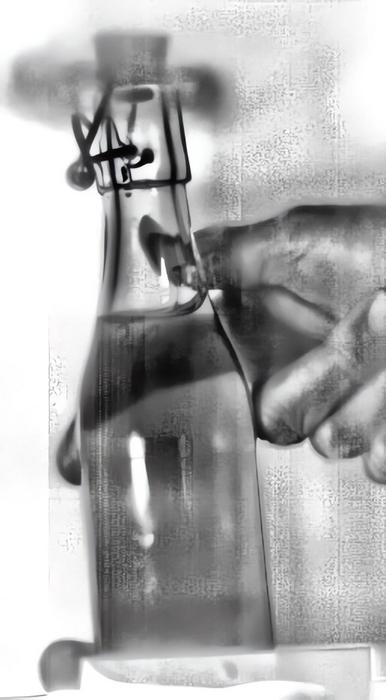
In an intriguing exploration of acoustics and fluid dynamics, a researcher at the University of Göttingen, Max Koch, embarked on an unusual yet captivating experiment involving the opening of a homebrewed swing-top beer bottle. Fueled by both scientific curiosity and a passion for homebrewing, Koch enlisted the help of Robert Mettin, head of the Ultrasound and Cavitation group at the university’s Third Institute of Physics. Together, they analyzed the complex interactions of sound, gas, and liquid that manifest when one opens a pressurized beverage. This project not only aimed to explain the peculiar “pop” of a bottle being opened but also to investigate the underlying physics principles that dictate this phenomenon.
Using a sophisticated high-speed camera, the research team captured slow-motion footage of the moment a swing-top beer bottle is opened. Contrary to common belief, the sound produced during this moment was determined to be more than just a simple noise; it was unveiled as a rapid, distinctive “ah” sound. Their analysis demonstrated that this sound originates from a vibrating wave generated within the bottleneck, which can be observed in their high-definition recordings. This unique sound wave is indicative of the tumultuous dynamics occurring immediately after the lid is removed.
Their findings suggest that the mechanism behind the well-known popping sound is not merely due to the release of pressure but results from a highly complex interplay of forces at work. Observing the erratic behavior of the gas and liquid mixture, the researchers stated that the sound does not emerge from a singular shockwave in the conventional sense; rather, it is a collection of rapid acoustic events linked through fluid motion. By employing high-fidelity audio recordings and computer simulations, the research corroborated the existence of this standing wave within the bottleneck that generates the audible resonance characteristic of a freshly opened beer.
The results of the study highlighted not only the remarkable acoustics but also significant thermodynamic implications. It was noted that as the cap is removed, the expansion of the carbon dioxide and air mixture within the bottle leads to a rapid cooling event. The temperature can drop dramatically, reaching levels as low as minus 50 degrees Celsius. This cooling effect significantly affects the speed at which sound travels through the gas, hence the lower frequency of the emitted sound compared to the higher pitch produced when one blows into a full bottle, likening it to the sound produced by a whistle.
Koch explained the fascinating correlation between sound frequency and thermodynamics, pointing out that the rapid decompression of the gas mixture causes a sound that is not only loud but comparable to the sound emitted by an airplane’s turbine. This revelation was particularly significant, as it challenges longstanding assumptions related to sound propagation and storage within closed systems, especially under varying pressures and temperatures.
The dynamics of the liquid inside the bottle were equally mesmerizing. Upon the bottle being opened, the dissolved carbon dioxide rapidly separates from the liquid, conjuring a phenomenon known as gushing. Observations from the high-speed camera indicated that this gushing action resulted from waves of liquid sloshing around, accentuated by the lid’s momentum striking the glass at the moment of release. Their analysis noted that this recoil could lead to an increased formation of bubbles, further complicating the acoustic signature associated with opening a beer.
During their research, the team faced numerous challenges, particularly in modeling the acoustics associated with the sound produced. Despite their substantial computational simulations that predicted a sharp peak in acoustic emission right before the “ah” sound, this anomaly was not captured in their actual experiments. This discrepancy highlighted the existing gaps in understanding the full scope of fluid dynamics involved in such familiar processes.
In a light-hearted aside, Koch acknowledged another hurdle: maintaining composure and clarity during testing after consuming the homebrewed products, underscoring the inherent challenges of combining rigorous scientific investigation with the joys of brewing.
As a culmination of their extensive research, the team prepared to publish their findings in the esteemed journal, Physics of Fluids, under the title “On the popping sound and liquid sloshing when opening a beer.” The significance of this work not only lies in its widening scope of inquiry into everyday phenomena but also in its contribution to the broader field of fluid dynamics, showcasing how traditional culinary processes can drive fascinating scientific discoveries.
The researchers proposed that their study opens paths for future research into similar acoustic phenomena generated in other fluid systems, perhaps even extending into industrial applications where understanding the sounds produced by various processes could lead to enhanced safety measures or quality controls.
Finally, these findings underscore the importance of interdisciplinary approaches in scientific exploration, demonstrating how the marriage of hobbyist passion with rigorous academic research can yield results that enrich our understanding of the world around us. This study not only highlights the scientific curiosity inherent in homebrewing but also exemplifies how such investigations can result in unexpected insights into the physics of fluid dynamics and acoustic behavior.
Subject of Research: The acoustics and fluid dynamics of opening a beer bottle.
Article Title: On the popping sound and liquid sloshing when opening a beer.
News Publication Date: March 18, 2025.
Web References: DOI link.
References: Physics of Fluids.
Image Credits: Max Koch.
Keywords
Acoustic waves, Cavitation, Fluid dynamics, Sound propagation, Physics.
Tags: acoustics research in beverage industrybeer bottle opening physicsfluid dynamics of beveragesgas-liquid interactions in bottleshigh-speed camera analysishomebrewing experimentsMax Koch scientific experimentspressure release in beveragesscience of sound in brewingsound wave generation in bottlesswing-top beer bottle acousticsUniversity of Göttingen research





